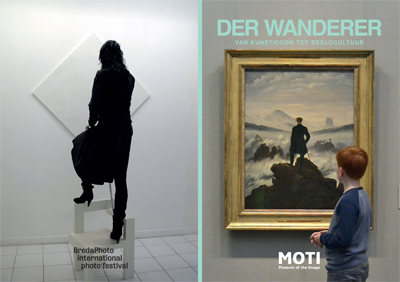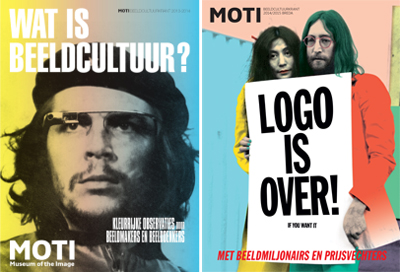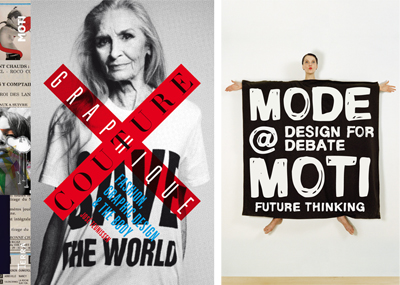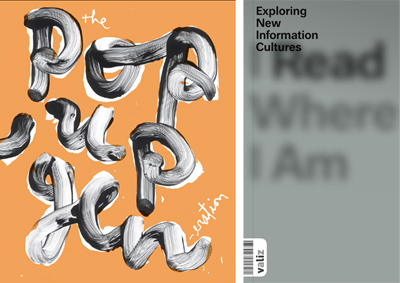Co-edited Publications
My activities with various organisations have meant that I have participated in many books and publications. That started around 1990, with the design of editorial printed material and it spread slowly to editing books and publications. Many books arose on my initiative. Below there is a selection of publications from the last 15 years, which I still consider relevant today.

Der Wanderer, from art icon to image culture
This publication places the painting “Der Wanderer über dem Nebelmeer” by Casper David Friedrichs in the context of all the image material that references the painting, plagiarises the picture or copies it. We see how Der Wanderer appears in a wide diversity of media over the years, each time in a new variation. New meanings and contexts are identified which allows the image to develop further and also give rise to new stories. In the image culture, old icons are brought back to life. A publication of MOTI, Museum of the Image.
Der Wanderer
Published by MOTI
First edition 2014
ISBN: 90-72007-69-7

The Image Culture Newspaper
The image culture newspaper is published once a year by MOTI and introduces various aspects and phenomenon in image culture. The editorial team of MOTI works throughout the year on one such issue. The first newspaper introduced the phenomenon of image culture, and the second takes a closer look at the current logo culture. At the moment, work is under way on the next issue. Its theme is icons in the image culture. The image culture newspaper can be obtained in MOTI and in other cultural institutions throughout the Netherlands.

Couture Graphique
Thanks to the modern media, a person in the year 2012 sees more images in one day than a person in the middle ages would see in his entire lifetime. Fashion is part of the explosive image culture which we experience daily in the media. Because fashion changes so rapidly, it is sometimes comparable to the transience of social media. The T-shirt has now gained the function of a pamphlet on which you can feature a quote or message. In her book, José Teunissen illustrates the rich graphic image culture of fashion and shows that this has roots going deep into the past. A publication of MOTI and Artez.
Couture Graphique
Published by Terra
First edition 2013
ISBN: 9089895558
MODE@MOTI
This report contains a summary of the topics of discussion and lectures of the first Mode@MOTI expert meeting that took place in 2013 in the Museum of the Image in Breda. The starting point of the Mode@MOTI Masterclass is to research challenges concerning technological developments in the field of fashion. The aim of the master class is to increase knowledge and to open the debate on the future value and content of fashion.

Popup Generation
The new generation of image makers born at the end of the previous century were just able to enjoy an analogue education and upbringing, but were then swept away by media consumption and technological development. This generation is more aware of the radical changes that the digital revolution has unleashed in society than those born after the year 2000. In this book, compiled by Lidewij Edelkoort for MOTI, we present work by this Popup Generation. Work featuring characteristics of the Popup philosophy: temporary, mobile and recyclable. Geproduceerd door MOTI and Lidewij Edelkoort.
Pop-up Generation
Published by Bis Publishers
First edition 2012
ISBN: 906369282X
I Read Where I Am
I Read Where I Am contains visionary texts about the future of reading and the status of the word. We read anytime and anywhere. We read of screens, we read out on the streets, we read in the office but less and less we read a book at home on the couch. We are, or are becoming, a different type of reader. We carry complete libraries in our pockets. The question remains which shape will it take and what experience does one want? I Read Where I Am collected 84 diverse observations, inspirations and critical notes by journalists, designers, researchers, politicians, philosophers and many others. Produced by MOTI and Institute of Network Cultures.
I Read Where I Am
Published by Valiz
First edition 2011
ISBN: 9078088559

I Don’t Know Where I Am Going But I Want To Be There
Graphic design, that until the nineties appeared to be a small craftsman-like and particularly cultural profession, seems, in the 21st century, to have grown into a democratised discipline with a central position in the modern media. I Don’t Know Where I Am Going But I Want To Be There reacts to this development. The book relates the history of the graphic image culture and shows us where we are. The tradition of printed material has made way for visual communication in an explosive media landscape. A publication of MOTI.
I don’t know where i am going but I want to be there
Published by Bis Publishers
First edition 2010
ISBN: 9063692579
Me You And Everyone is A Curator
While museums are developing strategies to digitalize their collections, online cultural production is growing steadily, with hundreds of thousands of new images posted each day. A lot of potentially interesting work is being produced online, which never reaches the physical world. The distribution of this high quality work is increasingly decentralised, leaving museums, foundations and professional magazines at a loss on how to redefine their role as gatekeepers. On the other hand, the time spent daily behind the computer on internet networking is pushing the demand for a physical experience of our fleeting culture. Published by MOTI.

Magazine MOTI 2011
MOTI, Museum of the Image is appropriate in a turbulent time in which the world finds itself confronted with a cacophony of cultures, revolutions, economic crises, new mass media and technology. Images are decisive in important issues; image determines identity; image makes complex situations accessible; image appeals to the emotions and can influence reality. Before internet came into being, images belonged to artists, but today they belong to everybody. What do we do with image and what does image do with us?

The first MOTI magazines
At the time, MOTI was still known as the Graphic Design Museum and the museum signalled that enormous developments were taking place around the area of graphic design. The museum decided to embrace these developments and to change the name of the museum into MOTI, Museum of the Image. Under this name, the museum can present the current and future developments in visual communication to a wide audience. In these first magazines, the changes were already visible.

A project exploring the relationship between commerce and art, society and the workings of the market, and between the private and public domain, Artvertising presented a large facade, in Amsterdam, consisting of some 23.000 tiles. During the project the tiles were replaced by images, mostly of corporate and organizational logos, but also messages and art works that were purchased at a cheap and accessible price. The result of the project and the wide-ranging reactions are explored in this book.
Artvertising
Published by All Media
First edition 2007
ISBN: 9081165518
Masters of Rietveld

Masters of Rietveld
Published by All Media
First edition 2008
ISBN: 9081165526